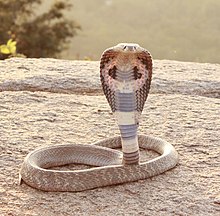| Indian cobra | |
|---|---|

| |
| Scientific classification | |
| Domain: | Eukaryota |
| Kingdom: | Animalia |
| Phylum: | Chordata |
| Class: | Reptilia |
| Order: | Squamata |
| Suborder: | Serpentes |
| Family: | Elapidae |
| Genus: | Naja |
| Species: | N. naja
|
| Binomial name | |
| Naja naja | |

| |
| Indian cobra distribution | |
| Synonyms[3][5] | |
| |
The Indian cobra (Naja naja), also known commonly as the spectacled cobra, Asian cobra, or binocellate cobra, is a species of cobra, a venomous snake in the family Elapidae. The species is native to the Indian subcontinent, and is a member of the "big four" species that are responsible for the most snakebite cases in India.[6][7]
It is distinct from the king cobra, which belongs to the monotypic genus Ophiophagus. The Indian cobra is revered in Hindu mythology and culture, and is often seen with snake charmers. It is a protected species under the Indian Wildlife Protection Act (1972).
- ^ de Silva, A.; Ukuwela, K.; Shankar, G.; Srinivatsulu, B.; Das, A.; Vyas, R.; Sawant, N.S.; Kulkarni, N.U.; Deepak, V.; Thakur, S.; Mohapatra, P.; Srinivasulu, C.; Achyuthan, N.S. (2021). "Naja naja". IUCN Red List of Threatened Species. 2021: e.T62241A3110222. doi:10.2305/IUCN.UK.2021-3.RLTS.T62241A3110222.en. Retrieved 16 May 2023.
- ^ "Appendices | CITES". cites.org. Archived from the original on 2011-06-15. Retrieved 2022-01-14.
- ^ a b "Naja naja". Encyclopedia of Life. Archived from the original on 30 March 2014. Retrieved 28 March 2014.
- ^ "Naja naja". Integrated Taxonomic Information System. Retrieved 23 March 2014.
- ^ Uetz, P. "Naja naja". The Reptile Database. Archived from the original on 4 March 2016. Retrieved 28 March 2014.
- ^ Cite error: The named reference
Whitaker & Captainwas invoked but never defined (see the help page). - ^ Mukherjee, Ashis K. (2012). "Green medicine as a harmonizing tool to antivenom therapy for the clinical management of snakebite: The road ahead". Indian J Med Res. 136 (1): 10–12. PMC 3461710. PMID 22885258.
